Boron (B)
- Helps in the use of nutrients and regulates other nutrients.
- Aids production of sugar and carbohydrates.
- Essential for seed and fruit development.
- Sources of boron are organic matter and borax
Copper (Cu)
- Important for reproductive growth.
- Aids in root metabolism and helps in the utilization of proteins.
Chloride (Cl)
- Aids plant metabolism.
- Chloride is found in the soil.
Iron (Fe)
- Essential for formation of chlorophyll.
- Sources of iron are the soil, iron sulfate, iron
Manganese (Mn)
- Functions with
Molybdenum (Mo)
- Helps in the use of nitrogen
- Soil is a source of molybdenum.
Zinc (Zn)
- Essential for the transformation of carbohydrates.
- Regulates consumption of sugars.
- Part of the enzyme systems which regulate plant growth.
- Sources of zinc are soil, zinc oxide, zinc sulfate, zinc chelate.
Related Images:
Calcium (Ca) deficiency guide
 Calcium deficiency guide
Calcium deficiency guide
Calcium occurs throughout the entire plant. It is used for many processes in the plant, however, calcium is most important for the growth process. It has a regulating effect in the cells and contributes to the stability of the plant. Plants have two transportation systems at their disposal: the xylem vessels and the sieve vessels.
Most nutrients can be transported via both systems, however, for calcium this is not possible. Since calcium can be transported almost exclusively via the xylem vessels, it is an element that deposes of little mobility within the plant. It is, therefore, important that a sufficient amount of calcium is always available in the root environment, so that it will be continuously available for absorption by the plant.
About calcium in short
- What is it and what does it do?
- Calcium is important to the growth process.
- Has a regulating effect in the cells and contributes to the stability of the plant.
- What can you see?
- Yellow/brown spots, surrounded by a sharp brown outlined edge.
- What can you do?
- Add calcium by applying a liquid lime fertilizer such as a calcium nitrate solution.
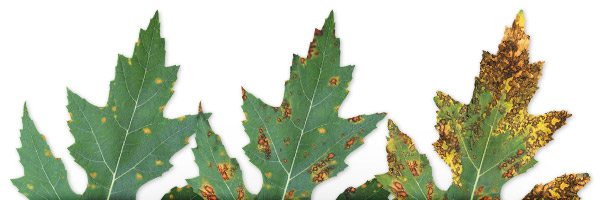
Symptoms of a deficiency
The older, larger leaves just above the bottommost ones will show the first symptoms. Yellow/brown spots occur, which are often surrounded by a sharp brown outlined edge. In addition, the growth is curbed and in serious cases the tops are smaller than normal and do not close.
Development of a deficiency
The symptoms often appear quickly; within one or two weeks the first spots being visible on the older leaves. The spots usually start as small, light brown specks that increase in size over time.
- After two weeks, the older leaves show ever increasing spots and the spots also often appear at the edge of the leaves, as with a potassium deficiency or with scorch symptoms. The spots have a sharp outline and do not originate exclusively at the edge of the leaves. A lag in development is often already noticeable within a week.
- Sometimes the growing points will wrinkle up and around the fruits you will find thin, small leaves that are not spotted.
- The older leaves die off slowly and yellowish cloudy spots may appear around the necrotic spots. The older the leaf is, the more serious the symptoms are.
- The flowering is also hindered and slowed down. Fruits stay small.
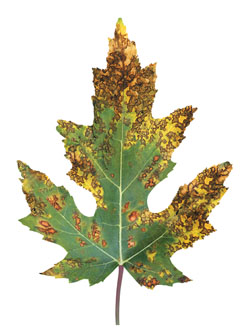
Reasons for a deficiency
- Culture on calcium fixing potting mix.
- An excessive amount of ammonium, potassium, magnesium and/ or sodium in the root environment. The absorption is curbed mostly by ammonium and least by sodium.
- Problems with the evaporation caused by an excessively high EC value or by excessively high or low relative humidity.
Solutions to a deficiency
- If the EC value of the substrate or the potting mix is too high, it can be easily rinsed out with pure and if necessary acidified water.
- Additional calcium can be applied through the nutrient solution by means of liquid lime fertilizers such as a calcium nitrate solution. With an excessively acidic potting mix, lime milk can be used to increase the pH. Use the appropriate potting mix that is not too acidic. Acid potting mix often contains insufficient amounts of lime. Good potting mix and Coco substrates are already limed.
For your information: Be careful with fertilizers containing chloride.
Related Images:
Magnesium (Ca) deficiency guide
 Magnesium deficiency guide
Magnesium deficiency guide
About magnesium in short
- What is it and what does it do?
- Magnesium is indispensable to plants as it is essential for photosynthesis.
- Represents a building block for chlorophyll.
- What can you see?
- Rusty brown spots.
- Cloudy, vague yellow spots between the veins.
- What can you do?
- Spray with a 2% solution of Epsom salts every 4-5 days during about a week.
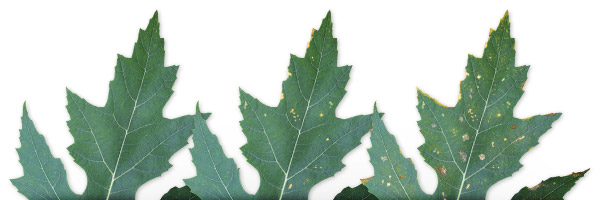
Symptoms of a deficiency
When there is a shortage, the leaf green in the medium-old leaves under the flowering top will be broken up, and the magnesium will be transported into the young parts of the plant. This breakdown is visible as rusty brown spots and/ or vague, cloudy, yellow spots between the veins. A slight shortage of magnesium hardly affects flowering, although the development of the flowers make the deficiency symptoms worse.
Development of a deficiency
- Signs of a deficiency first appear around the 4th-6th week. Small, rusty brown spots and/or cloudy yellow flecks appear in the middle-aged leaves (under the top of the plant).
- The color of the young leaves and the fruit development are not affected.
- The size and number of rust-brown spots on the leaves increase.
- The symptoms spread out over the whole plant, which looks ill. When the shortage becomes acute, the younger leaves are also affected and the flower production will be reduced.
Reasons for a deficiency
The magnesium deficiency can occur because uptake is inhibited because of:
- A very wet, cold and/or acidic root environment.
- A high quantity of potassium, ammonia and/or calcium (for instance high concentrations of calcium carbonate in drinking water, or clay potting mixes rich in calcium) in comparison with the quantity of magnesium.
- A limited root system and heavy plant demands.
- A high EC in the growing medium, which hinders evaporation.
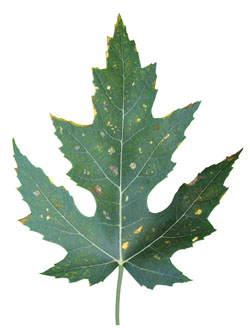 Solutions to resolve a deficiency
Solutions to resolve a deficiency
- When a shortage is diagnosed, the best thing to do is to spray with a 2% solution of Epsom salts.
- Fertilization via the roots: Inorganic: Epsom salts on hydroponics or Kieserite (magnesium sulphate mono hydrate). Organic: composted turkey or cow manure.
Recovery
Rectify the possible causes: In potting mixes, when the pH is too low (less than 5), use magnesium containing calcium fertilizers. In hydro, temporarily apply a nutrient solution with a higher pH (6.5). When the EC is too high, rinse and/or temporarily feed with drinking water only.
When growing indoors, keep the root temperature between 20 – 25 degrees Celsius. A little extra magnesium is not particularly harmful. When growing in potting mixes, excessive quantities of magnesium do not appear quickly. Too much magnesium inhibits the uptake of calcium, and the plant displays general symptoms of an excess of salts; stunted growth, and dark-colored vegetation.
Related Images:
Iron deficiency guide
Iron deficiency guide
Potting mixes seldom contain too little iron, but it is possible that forms of iron that can be absorbed by the plant are lacking. The absorbency of iron is strongly dependent on the pH. Usually, there is sufficient iron present in absorbable form in acidic potting mixes.
About iron in short
- What is it and what does it do?
- Iron has a number of important functions in the plant’s overall metabolism and is essential for the synthesis of chlorophyll.
- What can you see?
- Strong yellowing of especially the young leaves and growth shoots between the veins.
- What can you do?
- The best thing is to spray the plants with a watery solution of EDDHA or EDTA chelates.
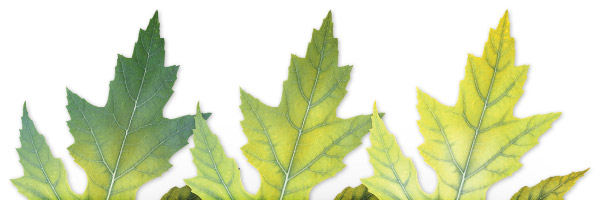
Symptoms of a deficiency
Iron deficiency can occur during periods of heavy growth or high plant stress and is characterized by a strong yellowing of the young leaves and the growth shoots between the veins. This occurs chiefly because iron is not mobile in the plant. The young leaves can’t draw any iron from the older leaves. With a serious iron shortage, the older leaves and the smaller veins in the leaf can also turn yellow.
Development of a deficiency
- Green/yellow chlorosis, from inside to the outside in the younger leaves and in the growth shoots. The veins remain mostly green.
- Continued yellowing of the leaves to sometimes almost white. Also, large leaves turn yellow. This inhibits growth.
- In serious cases the leaves show necrosis, and the plant’s growth and flowering are inhibited.
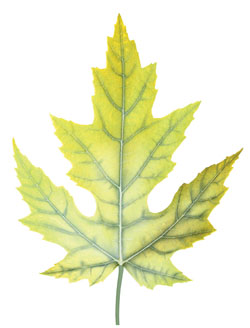
Reasons for a deficiency
- The pH in the root environment is too high (pH> 6,5).
- The root environment contains a lot of zinc and/or manganese.
- The concentration of iron is too low in the root environment.
- The root temperature is low.
- The root medium is too wet, causing the oxygen supply in the roots to stagnate.
- The root system functions inefficiently due to damaged, infected or dead roots.
- There is too much light on the nutrition tank; light promotes the growth of algae. Algae also use up the iron and break down iron chelates.
Solutions for a deficiency
- Lower the pH.
- Iron chelates can be added to the substrate.
- Drainage can be improved, or the ground temperature can be increased.
- A leaf nutrient with iron chelates can possibly be applied. If a good fertilizer is used with hydroponic growing, an iron deficiency is almost out of the question.
- The best thing you can do is to spray the plants with a watery solution of EDDHA (max. 0.4 grams per gallon) or EDTA chelates (max. 2 grams per gallon).
Related Images:
Manganese deficiency guide
Manganese deficiency guide
Manganese is generally taken up via the roots. Once inside the plant it is difficult to transport but not as difficult as calcium or iron for example. Silicon and molybdenum improve the transport possibilities for manganese in the plant.
About manganese in short
- What is it and what does it do?
- The metal manganese is an essential trace nutrient and acts as an activator for different enzyme reactions in the plant.
- What can you see?
- Yellow stripes appear between the leaf’s side veins.
- What can you do?
- Using products that contain trace elements (Tracemix).
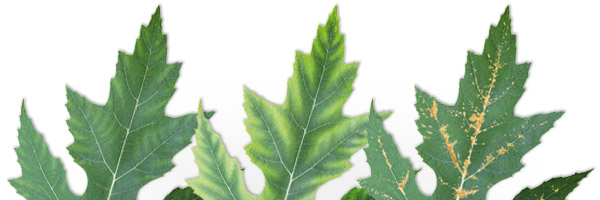
Symptoms of a deficiency
A manganese deficiency causes different physiological changes in the plant due to a decrease in protein production. Among others, this causes less nitrate to be fixed in the plant, which can lead to dangerously high levels of nitrate. Additionally, a lot of chemical reactions in plant cells slow down which may result in a build up of organic acids.
Development of a deficiency
The progression in chronological order:
- Yellow stripes appear between the leaf’s side veins on the larger leaves at the top of the plant.
- The yellowing between the side veins spreads further over the leaf and small, yellow/brown necrotic spots can form.
- The final result is a small plant (-10%) with minimum fruit/flower production.
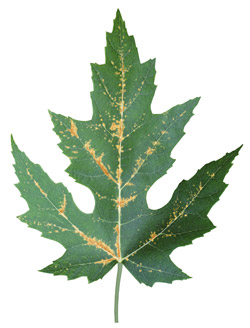
Reasons for a deficiency
In practice, the most common reason is that the pH in the substrate is too high. Like iron, manganese is easily dissolved at a low pH value in the substrate. If the pH is too low, a risk of excess manganese may occur. At high pH values manganese precipitates into manganese oxide (MnO2) which cannot be taken up by the plant which can cause deficiency.
Solutions to resolve a deficiency
- Check the medium’s pH when the first symptoms are noticed. High pH values mean that there is less manganese available for the plant. By lowering the pH of the nutrition (pH minus (down)) the medium’s pH can be lowered to 5.0 – 5.5.
- Low substrate temperature can be the cause of reduced manganese absorption. If a deficiency is noticed, check that the substrate temperature is sufficiently high (68 – 77 oC) during the day.
- Using products that contain trace elements may also help. A manganese deficiency is usually not a problem on its own. To facilitate manganese transportation in the plant, molybdenum is needed. Thus, the problem may well be a molybdenum deficiency. High levels of phosphorus may also result in a reduced availability of trace elements like zinc, copper and (of course) manganese. CANNA advises to use a mix of all needed trace elements. Trace elements can be given to the plant both in the feeding and by spraying the leaves. Spray the plant at the end of the day and spray daily with water after spraying to prevent burning.
Excess Manganese!
When there are high concentrations, manganese precipitates into manganese oxide (MnO2 or black manganese) which causes yellow-brown spots on the leaves. Initially, small spots will appear along the main and side veins of the leaf, following this, the spots will spread out from the veins. Excess manganese can be a result of a low pH in the substrate.
Related Images:
The History and Science of Epsom Salts
This natural mineral, discovered in the well water of Epsom, England, has been used for hundreds of years, not only to fertilize plants but to treat a range of human and animal ailments. Who hasn’t soaked sore feet in it at least once?
Chemically, Epsom salts is hydrated magnesium sulfate (about 10 percent magnesium and 13 percent sulfur).
Magnesium is critical for seed germination and the production of chlorophyll, fruit, and nuts. Magnesium helps strengthen cell walls and improves plants’ uptake of nitrogen, phosphorus, and sulfur.
Sulfur, a key element in plant growth, is critical to production of vitamins, amino acids (therefore protein), and enzymes. It’s also the compound that gives vegetables such as broccoli and onions their flavors. Sulfur is seldom deficient in garden soils in North America because acid rain and commonly used animal manures contain sulfur, as do chemical fertilizers such as ammonium sulfate.
The causes and effects of magnesium deficiencies vary. Vegetables such as beans, peas, lettuce, and spinach can grow and produce good yields in soils with low magnesium levels, but plants such as tomatoes, peppers, and roses need high levels of magnesium for optimal growth. However, plants may not show the effects of magnesium deficiency until it’s severe. Some common deficiency symptoms are yellowing of the leaves between the veins, leaf curling, stunted growth, and lack of sweetness in the fruit.
Magnesium tends to be lacking in old, weathered soils with low pH, notably in the Southeast and Pacific Northwest. Soils with a pH above 7 and soils high in calcium and potassium also generally have low magnesium levels. Calcium and potassium compete with magnesium for uptake by plant roots, and magnesium often loses. Sometimes, a soil test will show adequate magnesium levels in soil, but a plant grown in that soil may still be deficient because of that competition.
Gardeners add magnesium when they apply dolomitic lime to raise the soil’s pH. However, this product (46 percent calcium carbonate, 38 percent magnesium carbonate) breaks down slowly, and the calcium can interfere with magnesium uptake. For soils with a pH above 7, many gardeners use Sul-Po-Mag (22 percent sulfur, 22 percent potassium, 11 percent magnesium) to increase magnesium. Although dolomitic lime and Sul-Po-Mag are inexpensive ways to add magnesium, Epsom salts’ advantage over them is its high solubility.
When diluted with water, and especially when applied as a foliar spray, Epsom salts can be taken up quickly by plants. Epsom salts’ magnesium content, high solubility, and ease of application as a foliar spray are the main reasons for the positive results many gardeners see in their plants.